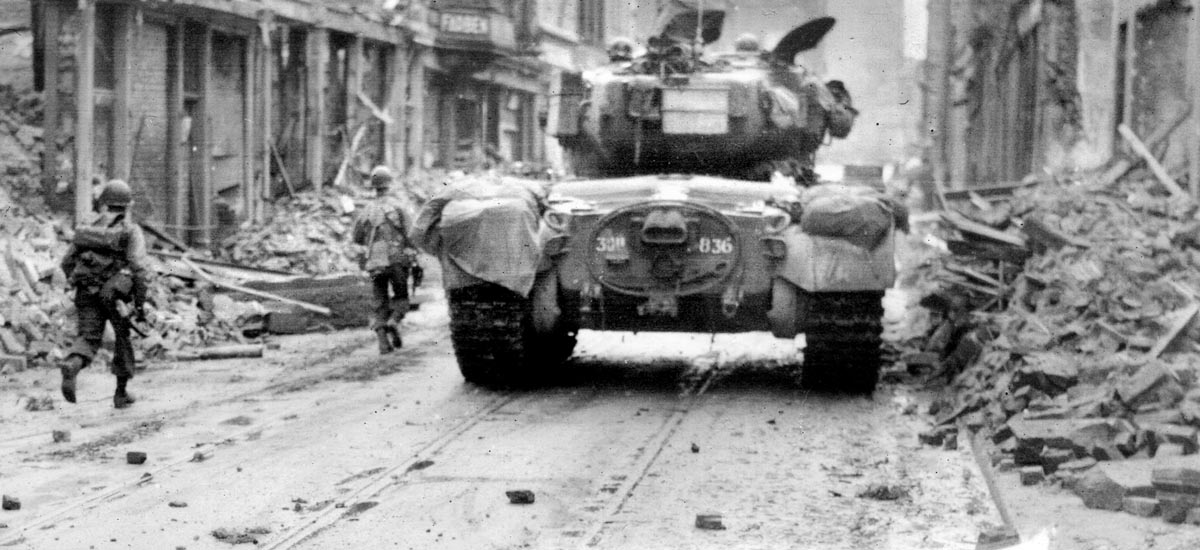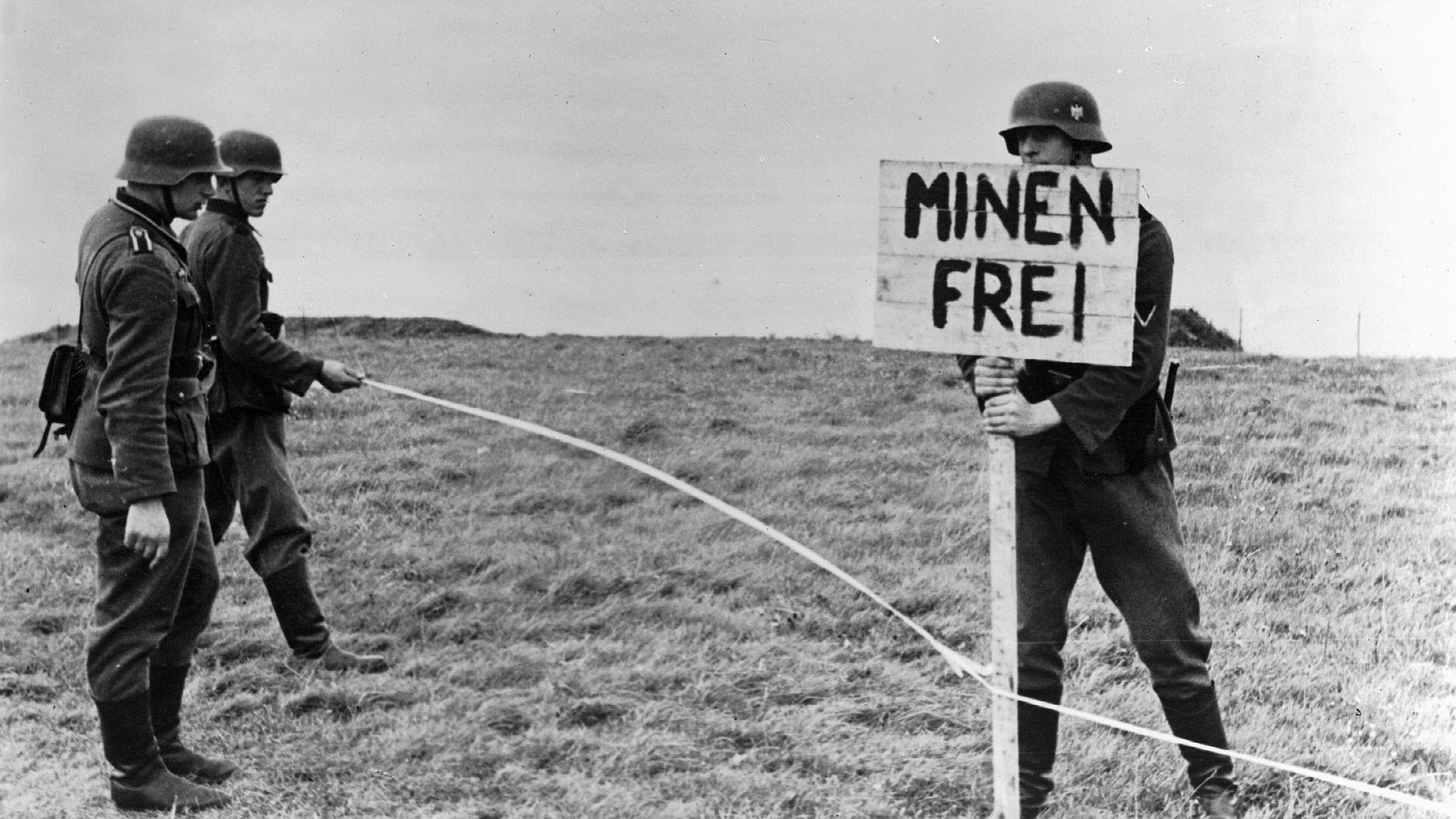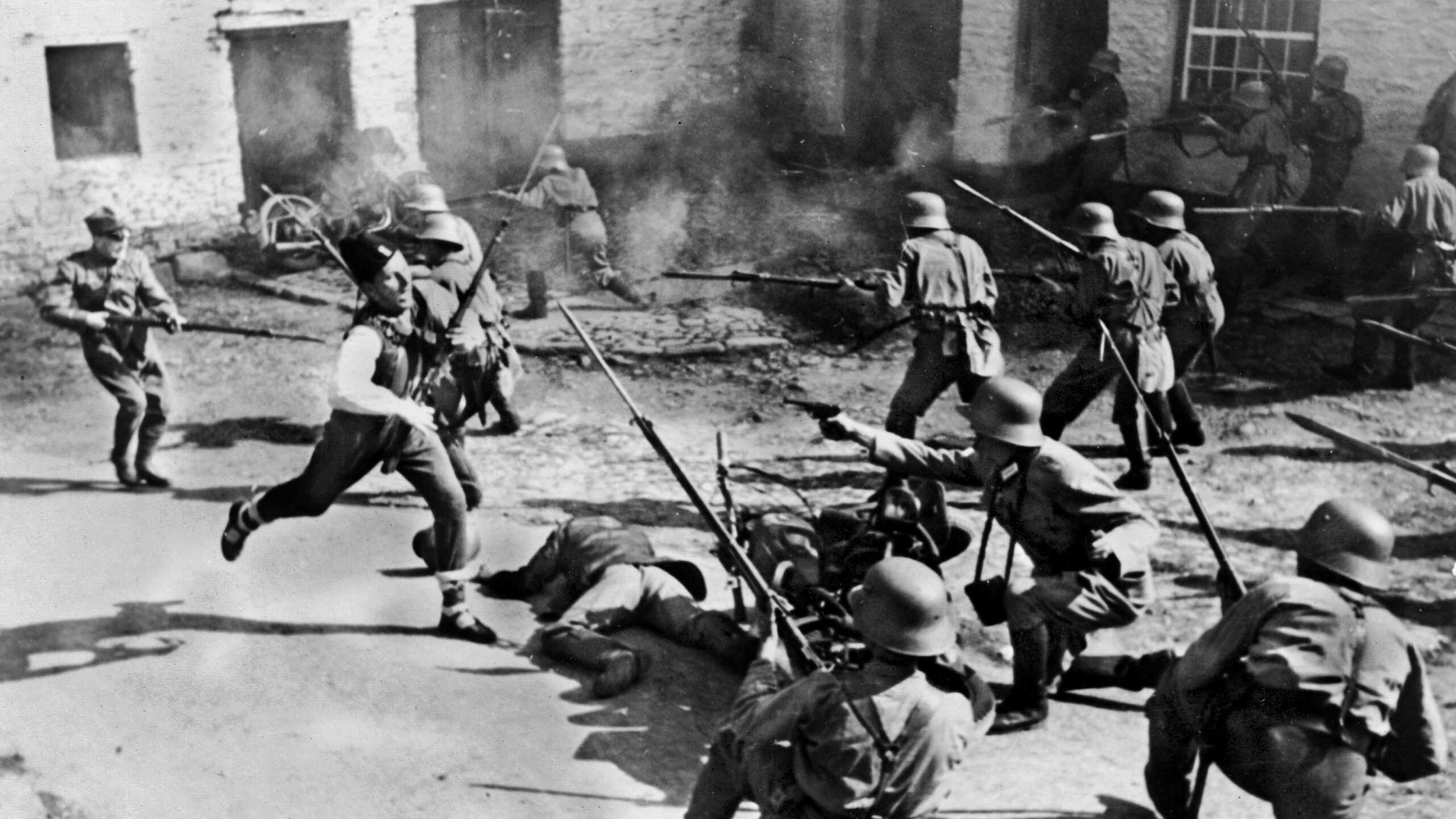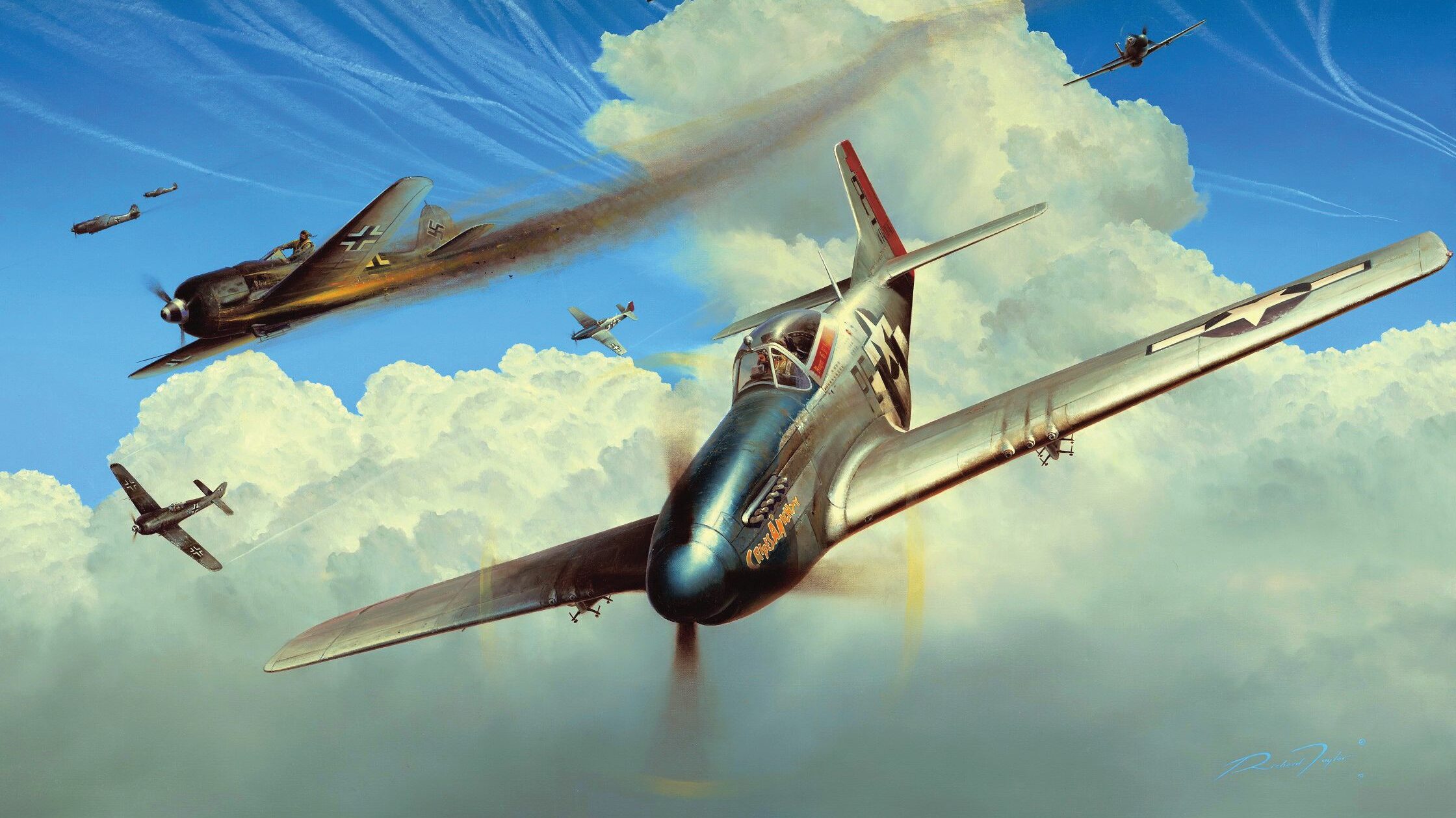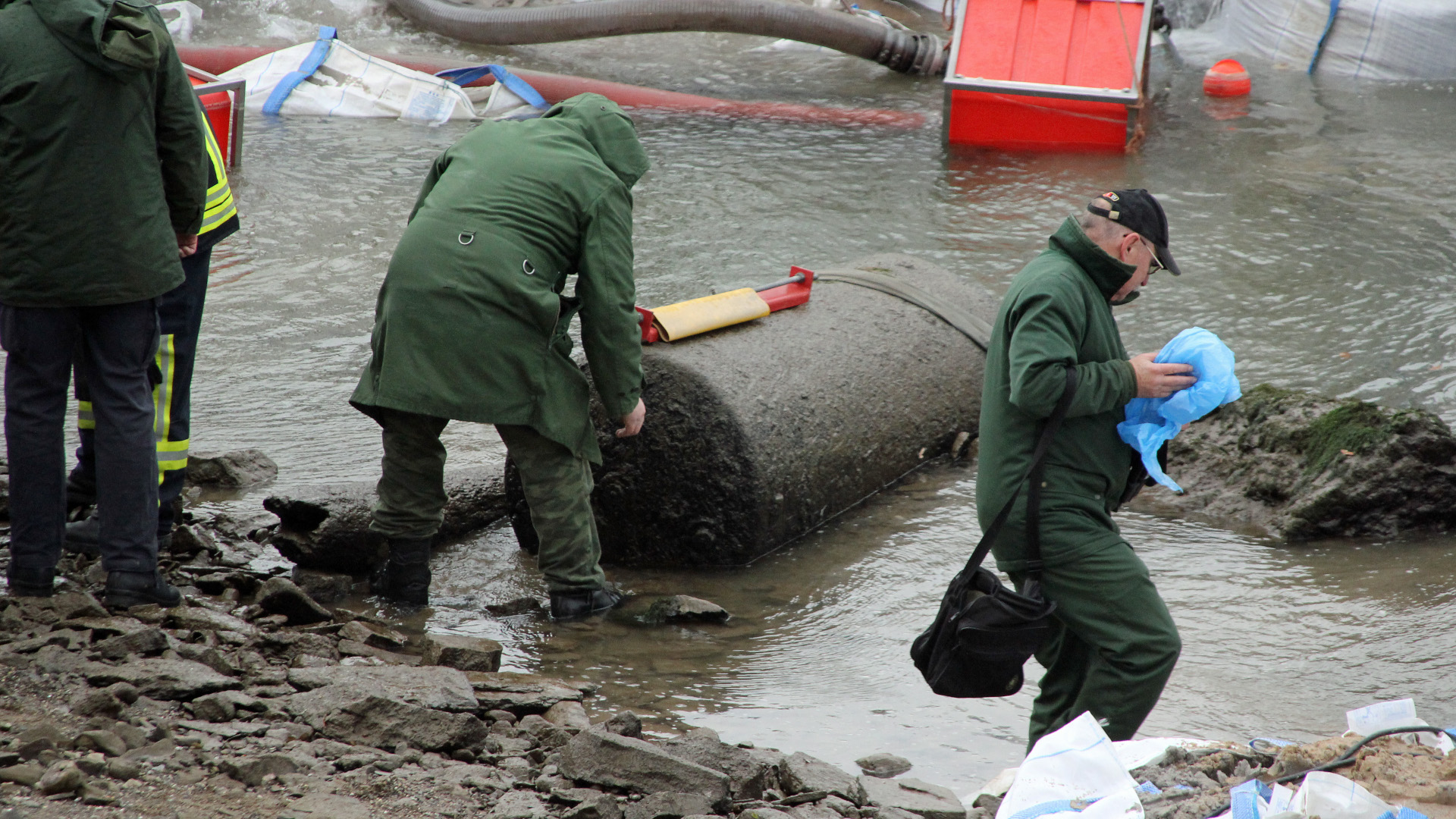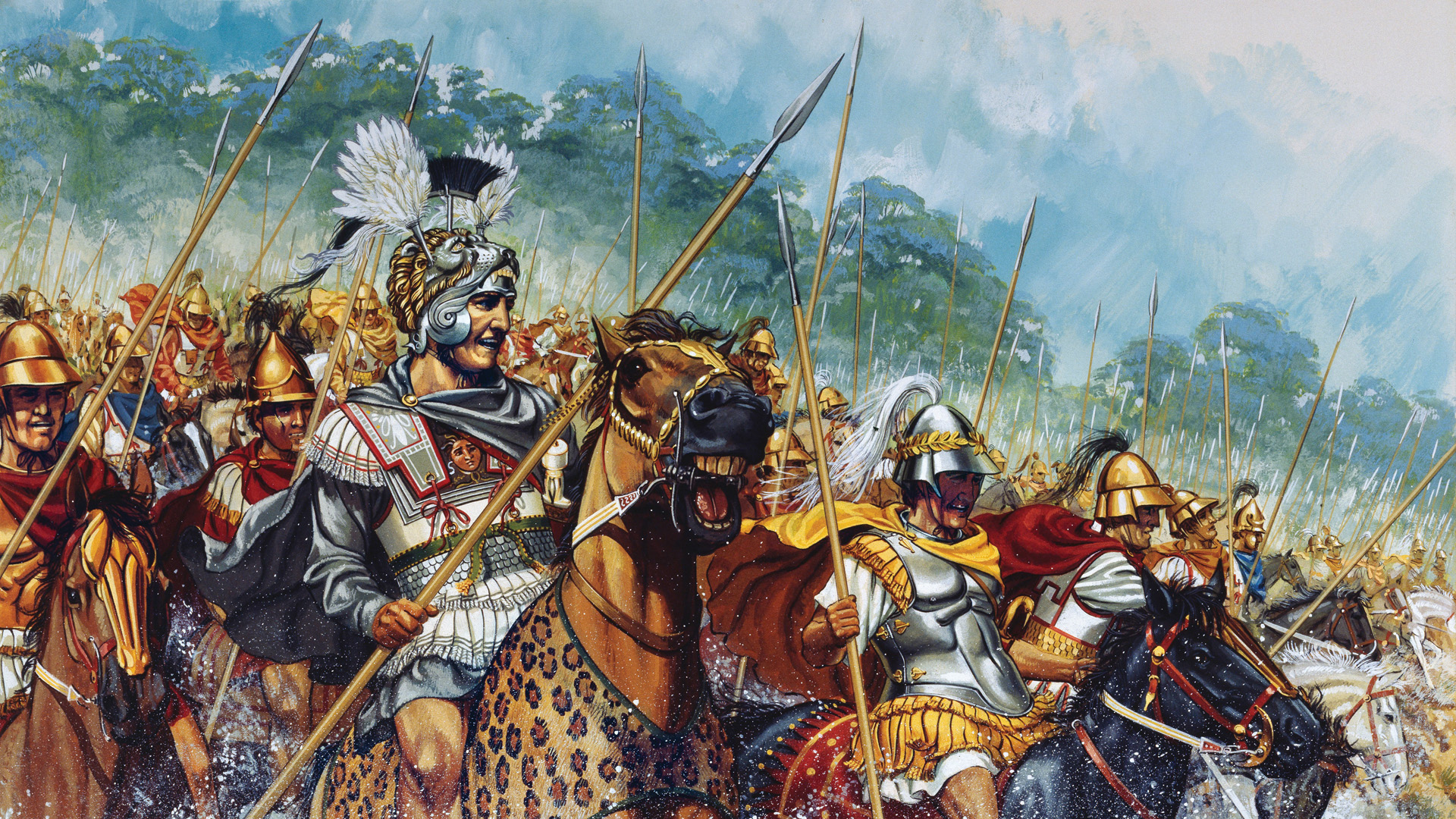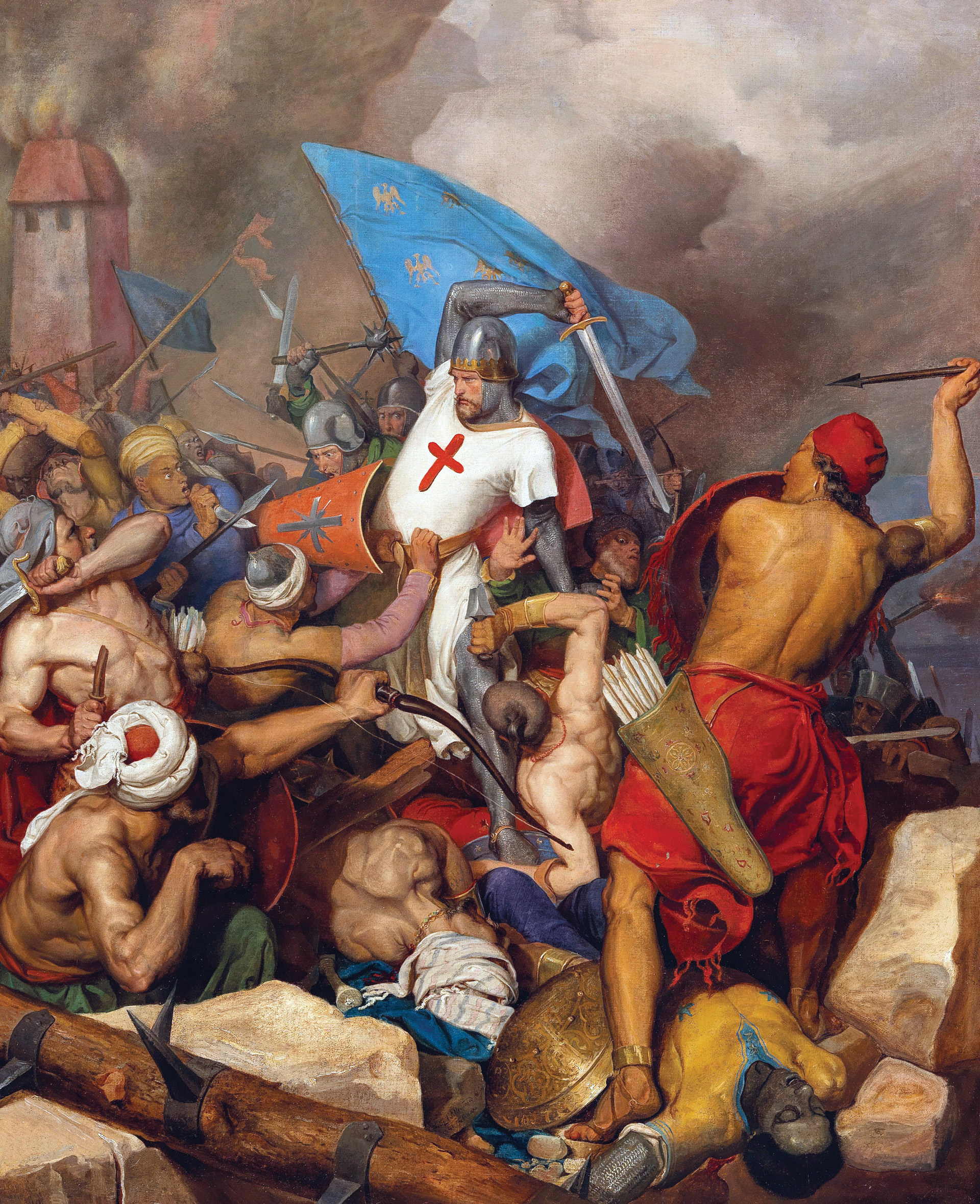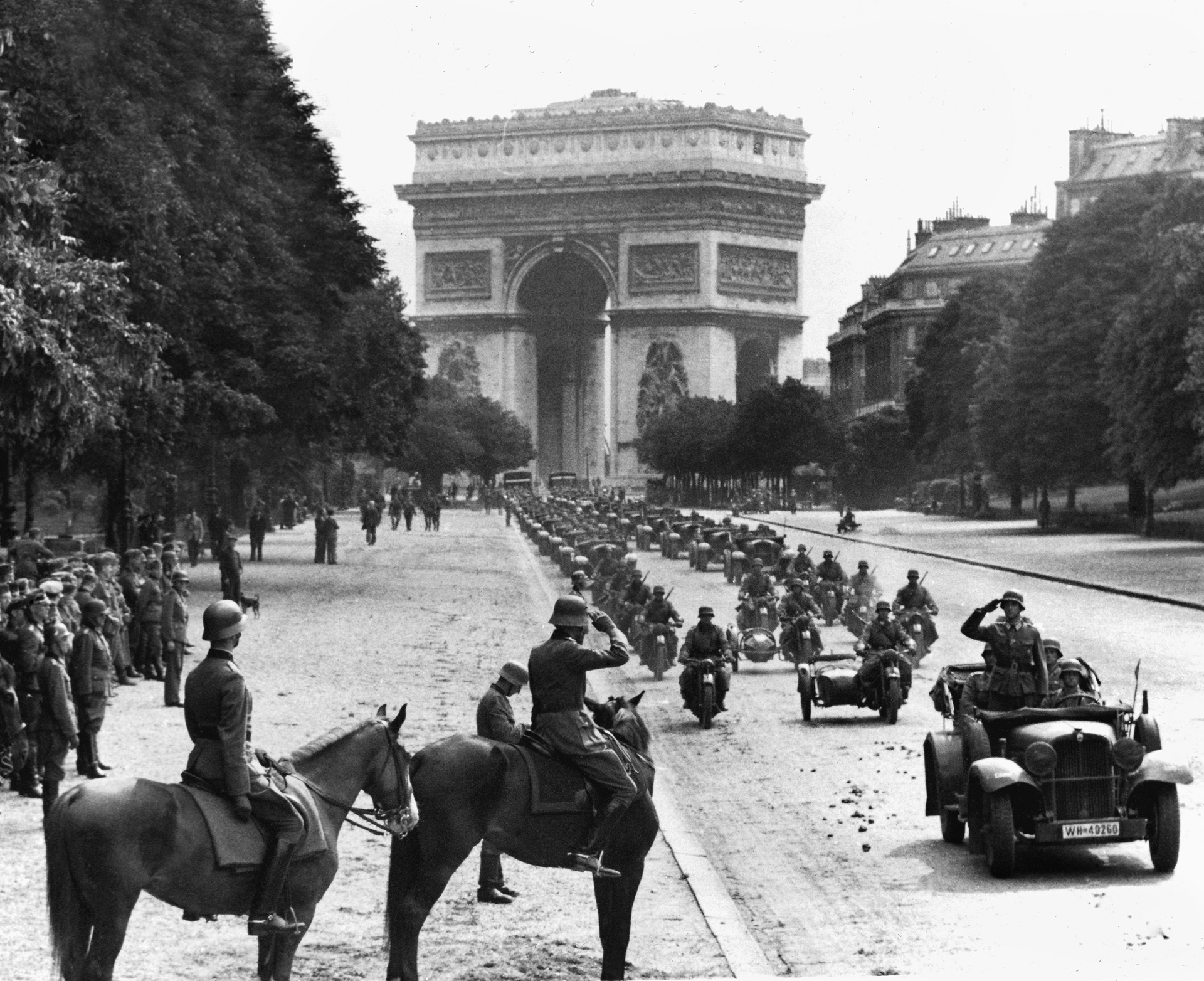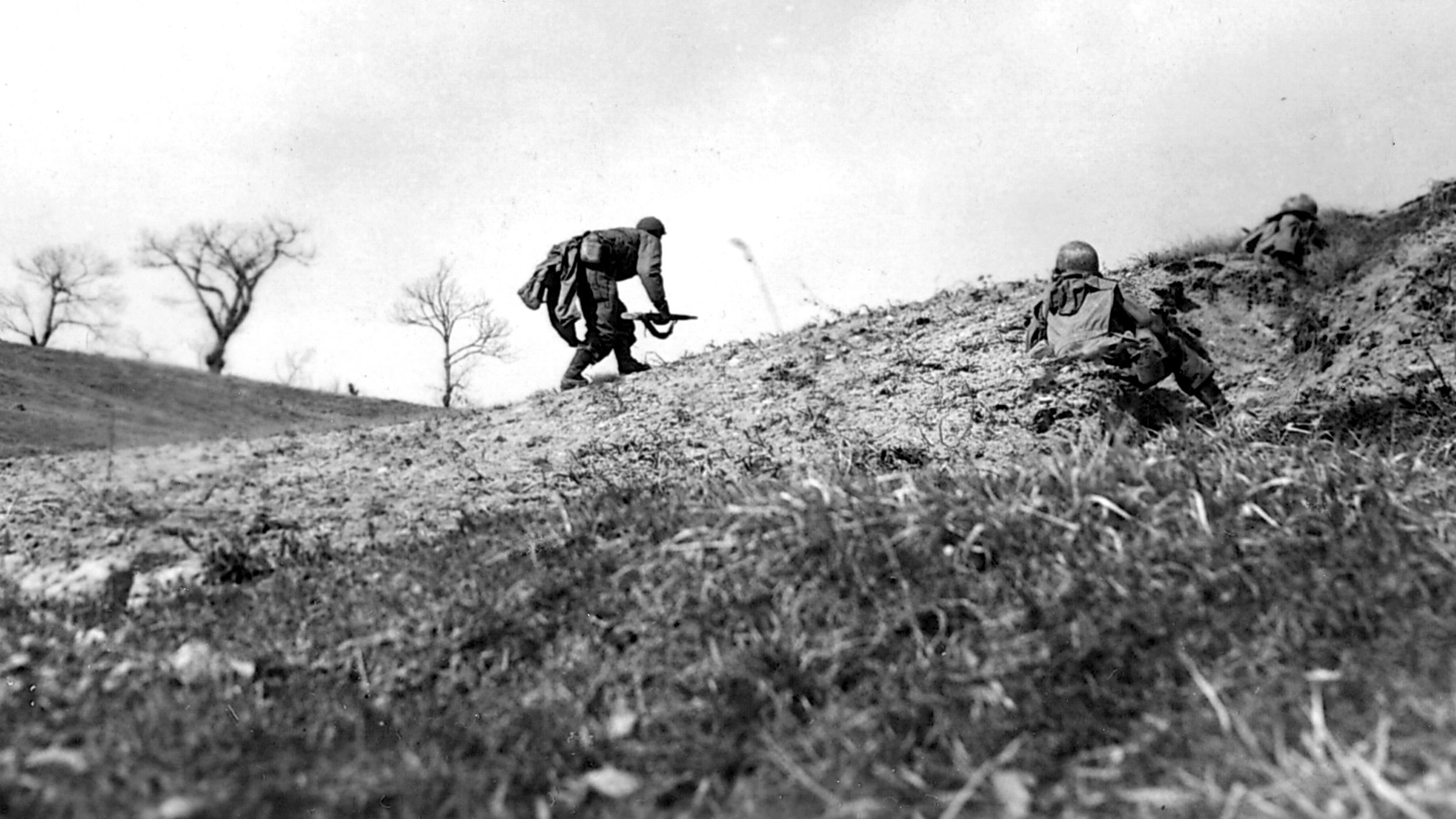By Christopher Miskimon
Sergeant Nicholas Mashlonik watched closely as the Panzerkampfwagen (PzKpfw) VI Tiger heavy tank rampaged through the village of Elsdorf in the Rhineland-Westphalia region of Germany on February 27, 1945. The 57-ton steel monster sported a long 88mm cannon that extended from a massive turret atop the blocky, angular mass of its hull.
The Tiger I was a fearsome opponent for any Allied tank crew in World War II. Mashlonik’s job that day was to knock it out. Had he been commanding the M4 Sherman medium tank that day, the task would have seemed almost impossible without support or reinforcement, but now the odds would be evened because of the new tank he would be taking into battle against the Germans. His crew awaited him in T-26E3, designated No. 40, a new American heavy tank that weighed 46 tons and boasted a 90mm cannon.
Mashlonik had done a quick reconnaissance of the village from a distance during which he had spotted the Tiger. The Tiger crew had entrenched their vehicle, thus making it a more difficult target. But Mashlonik still believed he could destroy it.
Returning to his T-26E3, which lay hidden in a small valley, the young sergeant crafted a plan. He would act as gunner for the mission while his normal gunner, Corporal Carl Gormick, took over as loader. Driver Ernest Cade would inch the tank forward until just enough of the vehicle was exposed so they could shoot. Mashlonik ordered his crew to prepare two armor-piercing shells and one high-explosive round. He hoped the armor-piercing rounds would knock out the tank and the round would kill the enemy crew. Immediately after firing the third shot, Cade was to reverse the tank to avoid return fire.
Cade slowly pulled forward, creeping to where the American crew could get an opportunity. Mashlonik saw that the Tiger was moving. By leaving its cover, the driver of the Tiger exposed the belly of his panzer where the armor was much thinner. Mashlonik fired one of the new T-30 high-velocity, armor-piercing shells from 1,000 yards away. With a fiery flash and a supersonic crack, the T-26E3’s gun sent the round crashing into the Tiger. The round smashed the transmission and drive assembly, stopping it immediately. The second round drilled straight into the Tiger’s thick gun mantlet and ricocheted down into the hull, setting the German tank ablaze. The Tiger crew tried to bail out of their stricken vehicle, but Mashlonik finished them off with two, rather than one, high-explosive rounds.
During the course of the long morning, the T-26E3 crew spotted three PzKpfw IV’s operating to the west of the destroyed Tiger. Mashlonik hit two of them, each panzer receiving an armor-piercing projectile followed by a high-explosive round. The remaining PzKpfw IV apparently beat a hasty retreat.
The three destroyed tanks brought Mashlonik’s tally to 15 tank kills since Normandy, three of which were carried out in his T-26E3. His skill and experience as a tank commander were the reason that he was given No. 40 only a few days before. The technical appellation of T-26E3 would soon be supplemented with the name of the late U.S. General of the Armies John Pershing when it was christened the Pershing and given the designation M26.
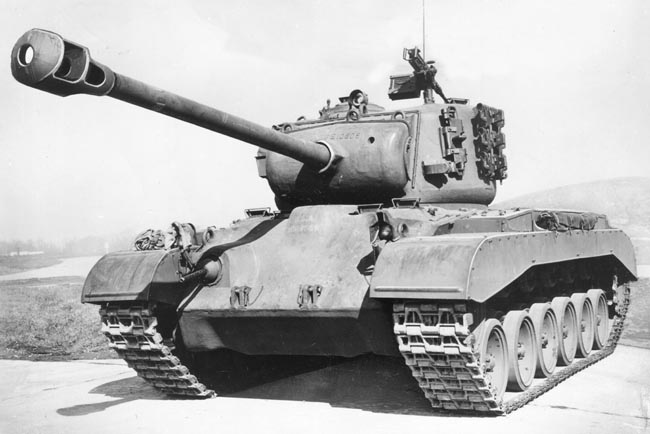
At the outset of Operation Barbarossa in 1941, the Germans faced formidable Soviet tanks, such as the T-34 medium tank and the KV series heavy tank, which prompted the Germans to develop powerful medium and heavy panzers capable of defeating these fearsome tanks in battle. Thus, the Germans became trapped in a vicious cycle of designing and fielding larger tanks with thicker armor and more powerful guns as they battled the Red Army on the Eastern Front. In response to the Soviet threat, the Germans introduced the PzKpfw V Panther medium tank and the Tiger I heavy tank. The Germans also fielded a number of powerful tank destroyers with direct-fire guns.
American tank crews, who first went into action in North Africa in late 1942 during Operating Torch, fought most of World War II in the Sherman. The M4 was a good tank in 1942, but as the war progressed the United States lagged in armored vehicle development. The Sherman was designed to be built by the thousands in American factories, shipped by rail to ports, and loaded into Victory Ships for transport to combat zones around the world. It had to be reliable and easy to maintain. The Americans shipped spare parts along with the Shermans to keep them in service.
As the battle for Germany heated up in late 1944, the M4s 75mm gun proved unable to pierce the thicker frontal armor of enemy vehicles, and its own armor was too thin to withstand the heavy shells of German guns. The Sherman was a great tank for the generals, who needed thousands of reliable tanks they could feed into far-ranging campaigns. For the tank crews, its virtues were appreciated, but they knew they were vulnerable to enemy fire. They also knew that in a tank battle they could not expect to win head-to-head confrontations.
The young Americans who made up the armored force were not shy about admitting these problems and eventually the complaints made their way to the top brass. The Army had actually been developing an improved medium tank since 1942, but bureaucratic infighting and confusion over whether a new tank was even needed delayed production.
Development continued during the bureaucracy’s debate, evolving from a prototype designated the T-20 to the T-26E1, which carried a 90mm cannon, four inches of frontal armor (equivalent to a Tiger I), and a Torqmatic transmission to save weight. Even so, the T-26E1 weighed more than 40 tons and, therefore, it was reclassified as a heavy tank. In early 1944, a team of armor experts was convened to study the need for a better tank. They concluded that the new heavy tank had to be capable of defeating enemy armor given that the Germans would always counter an armored penetration with their own armor. Thus, the Americans needed to field a tank that was superior to the enemy’s best tanks.
Further testing ensued, with more arguing over what constituted the best design. At long last the T-26E3 was authorized for production in November 1944. Yet the Army bureaucrats fretted over its battle-worthiness. This was prompted in part by after-action reports from the Battle of the Bulge that noted American tanks were prone to failure when they were needed the most. After some more agonizing, the Army shipped 20 T-26E3s to Europe for field testing.
The T-26E3s arrived in Europe as part of the Zebra Mission, whose purpose was to introduce a number of new weapons. In addition to the T-26E3s, other new weapons systems covered under the program were the self-propelled 155mm gun and a new type of 90mm antitank gun. Army ordnance specialists participating in the mission tackled the initial field problems encountered by the T-26E3. The Zebra Mission was assigned to Omar Bradley’s 12th Army Group. Bradley sent the T-26E3 to Lt. Gen. Courtney Hodges’ First Army since Hodges’ units had the most contact with the Tigers.
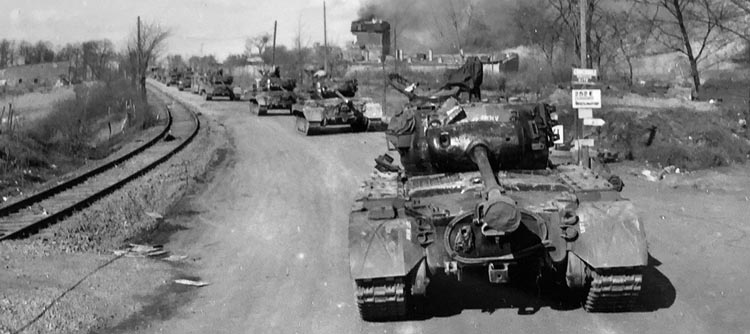
Major General Maurice Rose’s 3rd Armored Division and Maj. Gen. John W. Leonard’s 9th Armored Division each received 10 tanks. The tanks arrived at Antwerp and were quickly shipped forward to a maintenance facility near the recently occupied town of Aachen, arriving on February 17, 1945. Each division sent 10 crews to become familiar with the new vehicles.
To get maximum advantage out of the new tank, 3rd Armored sent its best tank commanders and crews, with the idea to allocate one T-26E3 to each of 10 tank companies in the 32nd and 33rd Armored Regiments. Most of the controls on the new tanks were similar to the Sherman so the training went smoothly. The Pershing had a different transmission, so the crews spent extra time learning how to operate it. Each crew fired 28 rounds of the main gun ammunition, which accustomed them to the greater flash and smoke of the 90mm cannon.
Tank Gunner Corporal Clarence Smoyer recalled getting his first look at the Pershing at Stolberg, just east of Aachen. Smoyer belonged to a tank crew led by Staff Sergeant Robert Earley, which had a flawless record of never having their tank knocked out. Earley’s tankers of 2nd Platoon, Company E, 32nd Armored Regiment were told to turn in their Sherman because they were going to be trained on a top-secret tank the U.S. Army was rolling out.
Smoyer was sitting in the gunner’s seat of a Pershing bearing the designation E7 on its fender. Despite his experience as a gunner, he was nervous. His practice with the new 90mm was set as a demonstration to his entire regiment. Earley sat behind him in the turret and soon made the situation even worse by revealing Rose was only 50 feet away. He stood to the left of the tank even with its barrel.
From the commander’s position, Earley ordered Smoyer to traverse right. The gunner looked into his sight and twisted his grip to the right, causing the massive turret to turn. The loader slammed a three-foot-long, armor-piercing round into the breech. Situated 1,200 yards away was a damaged farmhouse. Smoyer was told to aim for the chimney and fire when ready. He zeroed the reticle onto the target and prepared to shoot. The Sherman had a firing button on the floor, actuated by the gunner’s foot; in contrast, the Pershing had a trigger on the same grip used to traverse the turret.
Smoyer took a deep breath and pulled the trigger. The flash blinded him, the noise deafened him, and the muzzle blast knocked Rose and his entourage off their feet. The chimney exploded in a shower of bricks. All the enlisted men watching were impressed by the shot but hid their laughter at Rose’s predicament. Smoyer shifted to another chimney, this one 1,500 yards away. He hit that chimney and another one as well.
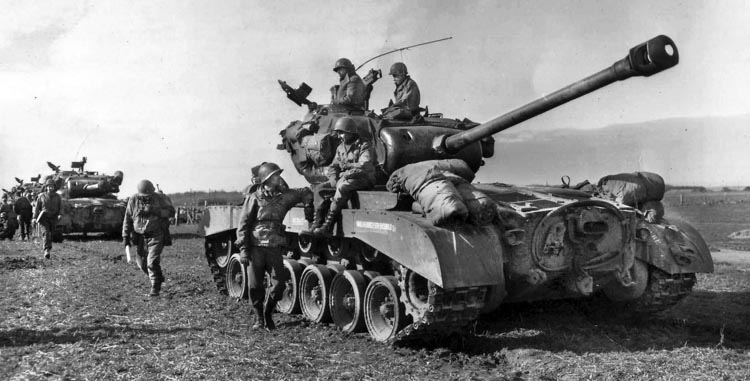
When Smoyer got out of the tank, the assembled men cheered and clapped, including a mud-spattered Rose. The new tank inspired the tankers, who finally saw an American tank that seemed able to match the best German armor. “Our gunnery is far superior to that of the Germans,” Rose told General of the Army Dwight D. Eisenhower. For his part, Smoyer could not contain his exuberance. “The Army needs to rush a whole bunch of these over here,” he told his fellow tankers.
Despite the need, for the time being the Pershing’s presence in Europe amounted to a few dozen tanks, but the crews put them to work. In late February, the U.S. First Army was preparing to undertake Operation Lumberjack, which had as its primary objective the clearing and capture of the west bank of the Rhine River.
On February 23 the 3rd Armored Division attacked toward Duren. Initially, the mud caused more delays than the enemy. Many of the local German antitank guns lay knocked out by artillery or abandoned by their crews. The division’s Task Force Welborn, named for its commander, Colonel John Welborn, turned northeast three days later toward the rail hub of Elsdorf, situated 30 miles due west of Cologne. The task force reached the southern end of the town late in the afternoon and quickly captured about 15 houses before nightfall.
German grenadiers, artillerymen, and Volkssturm defended Elsdorf. The Volkssturm was a militia-like organization of very old and very young levies scraped together to defend the Fatherland. The Volkssturm were armed with deadly Panzerfaust antitank launchers.
Generalleutnant Fritz Bayerlein, commander of the LIII Army Corps, who controlled the German armor in the area, knew the Americans would try to capture Elsdorf since it was a rail hub. He ordered a small kampfgruppe from the 9th Panzer Division to the town. This force included PzKpfw IVs and at least three Tiger Is. They arrived after dark and the local German defenders told the panzer crewmen there were Americans at the southern end of the town. One of the Tigers, turret No. 201, went forward until its crew could hear tank engines running ahead.
There were two American tanks nearby, both from F Company, 33rd Armored Regiment. One was a Sherman and the other a T-26E3 nicknamed Fireball.They were on the street positioned behind a tanksperren, a log wall designed as a tank obstacle and used to block roadways and intersections. The Tiger crew managed to sneak their tank to within 100 yards, not too difficult with the sound of tank engines drowning each other out on both sides. At 9 pm the Sherman erupted in flames, either from German artillery or a well-placed panzerfaust round. The flames silhouetted Fireball’s turret, exposing its exact position to the Germans. They took advantage of this opportunity and opened fire.
The first 88mm round went through the gun mantlet on the front of Fireball’s turret, killing gunner Corporal John McGraw and loader Private Francis Rigdon. A second shot hit the muzzle brake on the Pershing’s gun. This jammed the barrel and caused the loaded 90mm round to detonate. A third and final round ricocheted off the mantlet and tore off the opened commander’s hatch. It was a brief action, yet it proved the adage that in tank warfare the crew that first spotted and fired on the enemy held a decisive advantage over their opponent. After their victory, the German crew tried to back their vehicle down the street to cover, a normally sensible move that kept the tank’s heavier frontal armor toward the enemy. However, that night the Germans backed into the rubble of a house and the Tiger got stuck, forcing them to abandon it.
In response, the Americans pounded the area with artillery and awaited daylight. The next morning, tanks and infantry pushed deeper into southern Elsdorf where they ran into more German armor. After a Tiger and two PzKpfw IVs were destroyed that day, the remaining German tanks retreated out of town. A few days later during the advance to Cologne, Mashlonik’s crew knocked out another PzKpfw IV, making No. 40 the highest scoring Pershing of the war with four tank kills. The Americans recovered Fireball, which was eventually repaired and sent back into action.
As the tankers of 33rd Armored were fighting in Elsdorf, a few miles south Smoyer and the crew of his Pershing were advancing toward the village of Blatzheim along with the Shermans of Company E. A group of M5 Stuart light tanks had been fired upon from a nearby farm complex, knocking out one of them. The tank company attacked, moving in three rows with the Pershing in the middle to protect their firepower. Rain fell as they crossed a field and took up positions around the burning Stuart.
The leading Shermans trained their guns on the farm to their left, and the enemy soon opened fire with a 75mm antitank gun. A green tracer from the armor-piercing shot buried itself in the sodden ground near the tanks. A heated exchange of firepower ensued. The Sherman crews fired multiple rounds into the farm buildings. Suddenly more green tracers came from Blatzheim to their front. The Americans confirmed that they were facing formidable 88mm flak guns serving as tank killers. One Sherman was struck and two more suffered mechanical problems as the American tank company made a hasty retreat out of the killing zone.
F Company came in from the flank and cleared out the farm, allowing E Company’s 2nd Platoon to resume its attack toward Blatzheim, leading the rest of the company. As they advanced, one tank was hit and another threw a track. Another became stuck in a crater, leaving a Sherman and a Pershing to forge ahead. Suddenly a green tracer slammed into the turret of the Sherman and it came to halt. Earley’s tank was alone, advancing toward at least one enemy 88mm gun. Smoyer looked through his site for a target and the loader, Corporal John DeRiggi, gripped a shell, ready to reload. Smoyer looked for a target but could not find one.
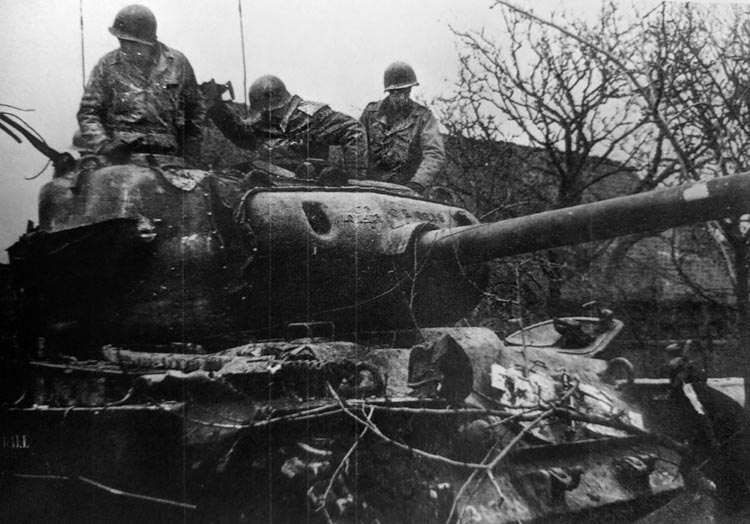
Then he spotted them. The guns were hidden under some trees where the nearby road entered the town. The gunner implored Earley to stop the tank so he could make an accurate shot. Earley complied as Smoyer told DeRiggi to load a white phosphorous round. Enemy shots struck the ground around the Pershing as Smoyer took careful aim and fired. The high-explosive round shattered a tree and started a fire around one of the 88s. Earley ordered the driver to reverse as DeRiggi reloaded. A round struck where they had been seconds earlier. Smoyer’s second round hit another tree and engulfed another 88 antitank gun in a sea of flame. Earley kept moving the tank between shots to throw off the enemy gunner’s aim while Smoyer put more shots into the enemy entrenchments.
The American tank crews succeeded in knocking out the enemy guns. Then, the Pershing rumbled into Blatzheim with the six remaining Shermans. The crew began replenishing their ammunition. A few Sherman tankers joked that the Pershing had been slow crossing the field—it was a bit slower cross-country than a Sherman. “I never saw any of you try to pass us,” Smoyer replied. That silenced them.
As the Americans crossed the German frontier during the Rhineland Campaign of later winter 1945, they noticed that resistance was beginning to crumble. By that point, the Germans had committed all of their reserve forces on the Western Front. The rapid advance of Rose’s 3rd Armored Division, VII Corps, U.S. First Army in late February kept the remaining elements of the 9th Panzer Division in the sector off balance, forcing them to commit their armored resources in piecemeal fashion.
On the night of March 3-4, Rose’s vanguard entered Worringen on the banks of the Rhine River directly north of Cologne. The 2,000-year-old city straddled the Rhine. It boasted a twin-spired cathedral that that had endured countless Allied air strikes on Germany’s fourth largest city. The cathedral remained standing despite 14 hits while the city blocks around it were flattened. The urban rubble offered superb defensive positions to the German panzers. By the time the Americans reached Cologne, it was defended by remnants of the 9th Panzer, 3rd Panzer Grenadier, and 363rd Volksgrenadier Divisions.
E Company sat before an overpass on March 5, waiting for the infantry to clear the way. The Pershing tank was in the lead, a somewhat dubious honor after the performance of both tank and crew at Blatzheim. Smoyer peered through the gunsight of his 90mm cannon, searching for targets. Despite the Pershing’s heavier armor, it was still vulnerable to a single German with a panzerfaust. The Royal Air Force had bombed Cologne just three days earlier. Smoke still rose from the fires that burned in the city. Heat and smoke from the many Allied aerial attacks on the city had left the spires of the ancient cathedral blackened and charred.
More infantry in half-tracks waited behind the American tanks. The infantry depended on support from the tanks and the tankers needed the infantry to sweep away marauding enemy soldiers and screen the tanks from threats they could not see. It was a symbiotic relationship; for in urban fighting the infantry would clear houses and kill anyone who tried to sneak up on a tank with a panzerfaust. In return, the tanks furnished firepower against strongpoints that the infantry had to capture and clear.
The delaying tactic worked that day. The Americans were held up for four hours before the order came to move in at 4 pm. The Pershing lurched into motion, leading one column of the task force, the other proceeding on a parallel route to the left. The Pershing advanced on a road that led toward the cathedral.
Each tank had a colored panel on the engine deck to identify it as a friendly vehicle to roving Allied planes. Tensions were high. Any window or doorway could hold an enemy ready to fight for the Reich; instead, the streets seemed empty, eerily devoid of life. As Smoyer peered through his sight, he saw something. A flash of light reflected off something on a clock tower almost a mile away. Worried it might be an enemy artillery observer peering at them through binoculars, he asked Earley to stop so he could make sure. The tank commander complied and Smoyer put a high-explosive round straight into the middle of the clock face. The tower collapsed in a rain of bricks.
The tanks fought alongside the infantry the rest of the day. The tanks blew gaping holes in buildings for the infantry to enter and machine-gunned German soldiers. Unknown to them, by the next morning there were several German tanks—a mix of PzKpfw IVs and Panthers—around the cathedral. The enemy’s situation around Cologne was desperate, with perhaps two dozen tanks remaining to defend the cathedral city. The Germans fought with great desperation. Snipers tried to pick off Americans, and young soldiers, some of them just boys, tried to get close enough to fire a panzerfaust or hurl a grenade at the Americans. The Americans pushed ahead toward the city center undeterred by the fanatical resistance.
The Pershing led the advance at midday with three Shermans behind it. To their front lay the cathedral, and just beyond it the Rhine River where a bridge still stood intact. Their orders were to get to that bridge and get across. It was a daunting task. The Germans would in all likelihood be entrenched on the far bank.
Some of the American tank crews felt they were being sent on a suicide mission. The streets were empty except for American infantry staying close to the tanks. Smoyer remembered being told the only vehicles on the street would be German military. No civilians had gasoline rations. The realization made the tank crews fear the appearance of German tanks.
The Americans crept toward the bridge, which was by then less than a mile away. They had no idea tanks awaited them near the cathedral. At 1 pm an explosion suddenly resounded through the empty streets from the east. Seconds later a column of smoke rose into the sky. From Earley’s position in the commander’s hatch of the Pershing, the smoke rose up between the twin spires of the cathedral. The driver stopped the tank as the crew realized the bridge they were ordered to cross was just destroyed by the Germans. The entire American force felt as if it had just received a reprieve from execution. They stopped and waited for the rest of the company to catch up. Earley radioed headquarters, hoping to receive an order to hold in place.
A reply soon arrived and was not what the tank crews had hoped to hear. They were ordered to continue to the Rhine, even though the bridge was down. Once again, the column moved forward, carefully, watching for any sign of the enemy. With the bridge down any remaining Germans could not retreat. The Pershing arrived at a four-way intersection and stopped in the shadows, just short of entering the open area. Smoyer peered through his sight, looking for targets. As he traversed the turret to the right, a German tank suddenly pulled out from behind the building to the left. He quickly swung his turret left, but the panzer reversed back behind a building before he could target it. Earley was looking in another direction and did not see it. Smoyer pointed out the building the panzer hid behind and aimed his 90mm in case it reappeared.
In the concealed PzKpfw IV, hull gunner Gustav Schaefer opened fire with his machine gun on a pile of rubble he thought concealed an American bazooka team. Smoyer saw the green tracers from the weapon pelting the rubble, but he kept his eyes fixed on the building for fear that the shooting might be designed to divert his attention. An armor-piercing round was sitting in the chamber of the 90mm, ready to destroy the enemy tank.
Both tank crews were distracted by a civilian car that suddenly flew into the intersection. The two civilians, a man and a woman, inside the vehicle had decided to try to make it out of the city as the battle heated up. They unwittingly drove into the middle of the unfolding tank clash. The Pershing’s crew mistook their vehicle for a military staff car, and their .30-caliber machine gun sent orange tracers ripping into the vehicle.
Schaefer, who also saw the vehicle, fired on it as well, sending a stream of green tracers into the target. The car came to an abrupt stop with the male driver slumped over the wheel. The female flung open the passenger door and collapsed on the ground. Neither civilian would survive the encounter.
Schaefer wondered what the civilians were doing driving into a battle, but he knew he had to stay focused on the threat from the American heavy tank. A short distance away, Smoyer saw the car stop, but was unable to see who had fallen out. He knew, though, that he had seen green tracers indicating a German weapon.
The German panzer was still behind the building. Smoyer took aim at the building where he thought the enemy tank was and fired. A small shower of bricks poured down but there was no other effect. They could not tell if the panzer was hit, but the bricks gave Smoyer an idea. He fired several rounds into the already damaged building until the structure finally gave way and the upper floors collapsed in a shower of bricks and dust.
The bricks covered the PzKpfw IV, jamming the turret. Schaefer was able to get his hatch open, pushing aside the bricks covering it. The tank’s commander also got his hatch open. He asked a civilian standing nearby for information, and the individual told him that the bridge had been destroyed. Schaefer fumed as he thought about how their unit commander had abandoned the panzer crew to their fate on the near bank of the Rhine. Angry about the situation, Schaefer implored his commander to abandon the panzer; he told the tank commander that further fighting was pointless. Some of the crew favored fighting on. They wanted to use the tank, whose turret would no longer traverse, like a direct-fire tank destroyer.
While the crew argued the matter, Schaefer climbed out of the tank and ran down the street. Moments later his commander followed him. The rest of the crew drove off in the damaged panzer. Schaefer said after the war that he never saw them again.
Meanwhile, the Pershing moved to a new position where the crew watched for more enemy tanks. On another street nearby several Shermans from F Company pulled forward slowly. Their job was to seize the cathedral, visible beyond the buildings at the end of the street. Afterward, the Stuart light tanks of B Company could dash to the Rhine and complete the battalion’s mission.
A large pile of rubble blocked the street, delaying the Shermans’ advance. The commander of the lead tank, Lieutenant Karl Kellner, looked for a way around the obstacle. Behind his tank was U.S. Army war correspondent Sergeant Andy Rooney, who would become a famous journalist after the war. Rooney clutched his camera and waited to see what would happen next.
Green tracers from a German armor-piercing shell flashed up the street and smashed into the gun mantlet of Kellner’s Sherman. Shrapnel flew into the tank, hitting the gunner’s legs. Within seconds another round hit, so close to the first the holes in the armor overlapped. The Sherman’s hatches flew open from the pressure of the blast. The driver of the other Sherman reversed to get out of the line of fire, but a third green tracer raced out of the distance and hit the tank’s right track. Still able to move, the driver broke left and backed the tank behind a ruined building. The crew leapt out as soon as it reached cover.
Smoke poured from Kellner’s knocked-out Sherman. Kellner climbed out of the commander’s hatch, clutching a carbine. He dropped it as he fell onto the engine deck, his left leg gone from the knee down. Smoke rose from the stump. The gunner climbed out of the turret and dove off. Kellner paused at the edge of the engine deck.
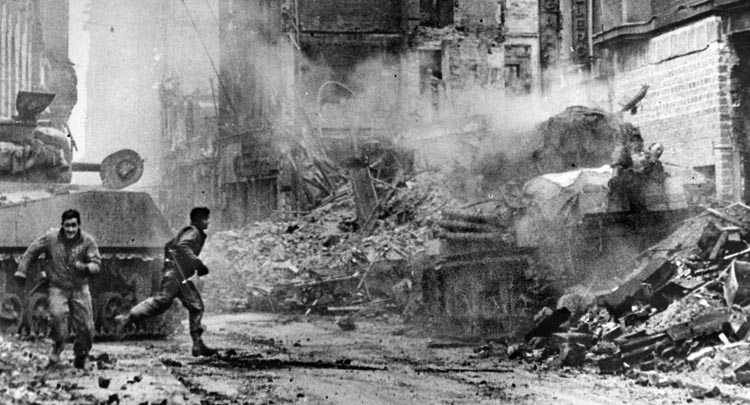
Rooney reacted immediately to try to save Kellner’s life. He summoned a medic and the two men, as well as a crewman from the other tank, lifted Kellner off the engine deck and carried him to a pile of rubble. Someone tied a tourniquet around the leg, but sadly Kellner did not survive the ordeal. The Sherman’s machine gunner also made it out of the tank; however, the loader and driver inside were dead.
It was an awful scene, made worse by the sudden sound of a German tank engine near the cathedral. The Americans all ran for cover. Ahead of them, a lone Panther tank appeared. Massive and angular, the Panther’s long 75mm gun jutted menacingly from its turret. Oberleutnant Wilhelm Bartelborth of Panzer Brigade 106 and his crew had not fled the fighting in Cologne like so many other German soldiers. They intended to fight to the finish.
Three hundred yards away, the Pershing and its crew sat waiting. They heard the radio transmissions about the nearby fight and knew some Americans were hunting the Panther. Army Cameraman Jim Bates ran up and shouted to Earley, telling him about the enemy tank, which seemed to be guarding the cathedral. Earley left Smoyer in charge and he and Bates went to investigate on foot. They dashed ahead into the no-man’s-land between the two sides and ducked into a building. From that location they spotted the Panther in the square in front of the enormous church, its gun lying across Kellner’s Sherman.
Earley decided he would bring his tank down the street, dart into the square, and take the Panther in the flank. He went back to the Pershing while Bates went higher in the building to try and record the coming fight. He found a window and steadied his camera. The Panther’s turret slewed to the right, directly toward Bates and the street the Pershing would take to attack. Bates ducked in the belief that the Germans had spotted him and were going to shell the building. When nothing happened, he peeked back through the window. He saw that the tank’s gun was still pointed in the direction from which the Pershing would appear.
As Earley ordered the Pershing to advance, he warned the crews of the Shermans to hang back. They were more vulnerable to the enemy tank. Smoyer told Earley he would aim for the hull to guarantee a hit at such close range. “Shoot wherever you want,” Earley told him. “He’s just sitting there like he owns the place.”
The loader held an armor-piercing round for a fast reload. Smoyer leveled his gun and turned the turret to the right as far as he could without hitting any buildings. He wanted to be ready to fire as soon as he spotted the tank.
The Pershing came to the intersection and went around the corner. Driver William McVey and bow gunner Homer Davis were the first to see the Panther, its gun pointed directly at them. The driver hit the gas and the Pershing lurched farther into the intersection, trying to get out of the line of fire. Smoyer saw it in his site, the muzzle of its cannon pointing straight at his tank, but the Germans did not fire. Bartelborth had never seen a Pershing before, mistook it for a panzer and told his gunner to hold fire. It gained the Americans the seconds they needed. Without hesitating, Smoyer fired.
The 90mm cannon lit with orange flame and a thunderous crack as the supersonic round raced from the barrel. In a fraction of a second it struck the Panther in its right side, punching through the armor plate and tearing into the tank’s engine compartment. Flames appeared immediately, partially obscured by the cloud of dust raised by the impact. Bartelborth leapt from the commander’s hatch of the Panther and jumped to the ground on the far side of the tank’s hull, away from the Pershing.
Through the cloud of dust, Smoyer could only see the outline of the tank and ordered DeRiggi to reload. He slammed another armor-piercing round into the breech as Smoyer adjusted his aim to just below the turret. He squeezed the trigger again and another flash lit the street as the high-explosive round slammed into the Panther just below its gun. A shower of sparks flew out from the point of impact as the projectile tore into the Panther’s crew compartment.
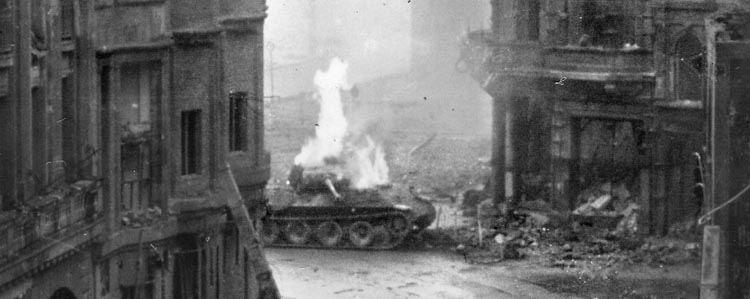
The concussion from the Pershing’s round caused Bates to shake in his perch in the building, throwing off the aim of his camera. As he struggled to get it back on the scene below, two more Germans climbed out of the tank. One came out of the loader’s hatch with his clothes in flames. Both of them scrambled off the panzer from the same side as their commander.
DeRiggi pushed another shell into the gun, and Smoyer took careful aim, this time at a point between the Panther’s wheels and its upper hull, where the armor was thinner. This third shot flew as straight and true as the others, slamming into the point of aim and finishing the tank for good. Tall flames roared from the Panther’s turret hatches as its surviving crewmen dashed off in search of cover. Smoyer could see his three shell holes in orange, backlit by the fire raging inside the enemy tank. It was impossible that anyone else might make it out of the Panther.
Early realized the fight was over and ordered the driver to reverse. The Pershing backed into a shadowy area away from the vulnerable intersection. DeRiggi threw the empty casings out to help clear the air of the cannon fumes. The entire crew breathed a sigh of relief. They were alive—only a second or two had made the difference that day. From around the corner they could hear the Panther’s ammunition cooking off.
Bates reappeared and told Earley he managed to film the entire fight. He also asked to film the crew as part of his footage of the event. Earley consented and the crew got out. Bates panned his camera in front of them, replaced the cap on the lens, and within a few minutes the Pershing was back in the war. Three Shermans joined it and they all moved cautiously to the train station next to the river. They reached it without taking any fire. The tankers stopped just short of the Rhine. They had accomplished their mission and were alive. For the moment, that was good enough.
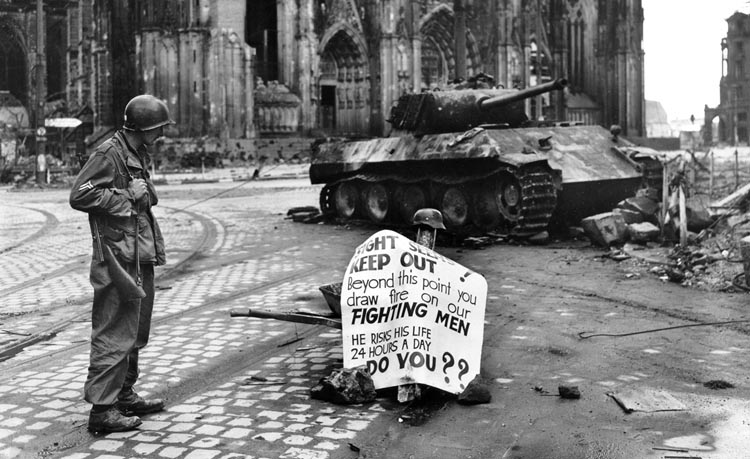
The duel between the M26 Pershing and Panther is one of the most famous of World War II, largely because Bates and his fellow cameramen captured it on film. Of course, thousands of tankers on both sides experienced similar close calls and were engaged in equally dramatic armored contests during the war. For that reason, Bates’ footage is merely representative.
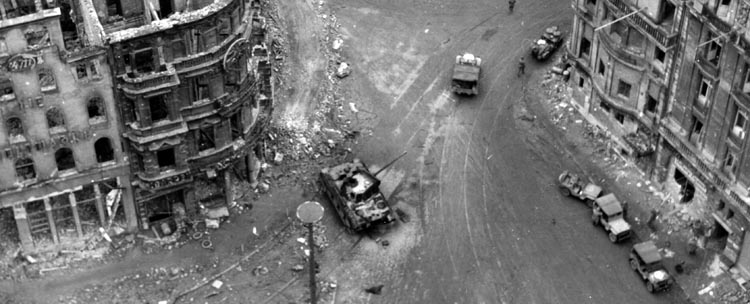
Despite its late introduction, the Pershing nevertheless had proven it was up to the job of carrying the war into Germany. Although it was far from invulnerable, when properly handled it could hold its own against the Third Reich’s best armor and antitank weapons.
Unfortunately for the Americans, only about 110 Pershings were integrated into U.S. armored units on the Western Front in Europe before the war ended. Still, the M26 Pershing was so successful it formed the basis of American tank design throughout much of the Cold War, resulting in the M48 Patton tank that remained in use for a number of decades after it was first introduced in the 1950s.
